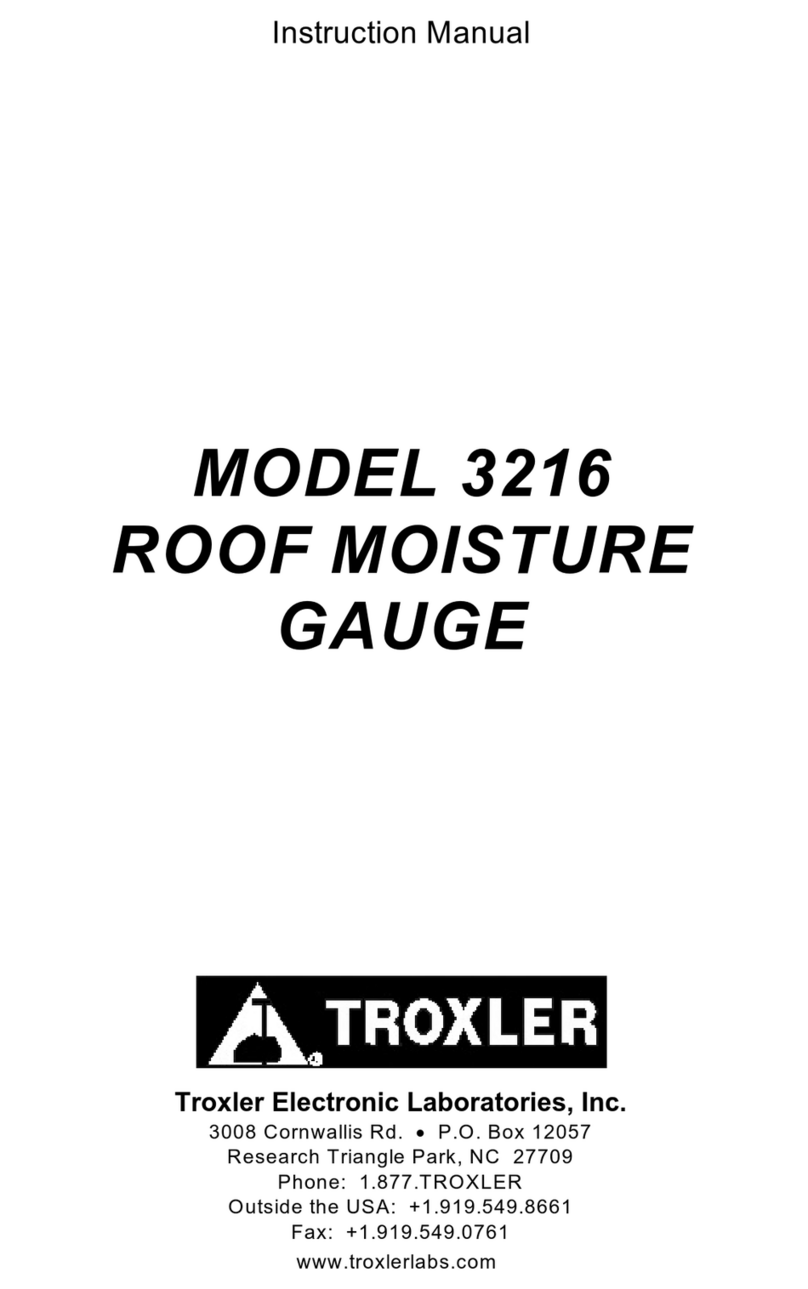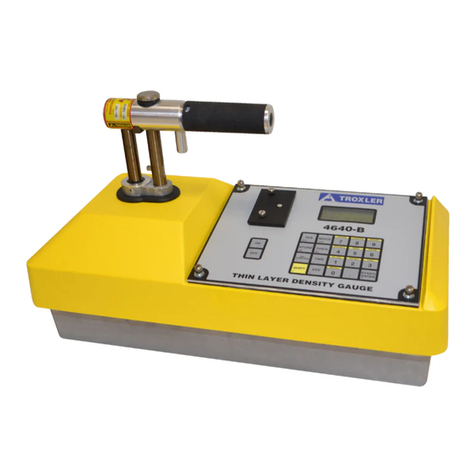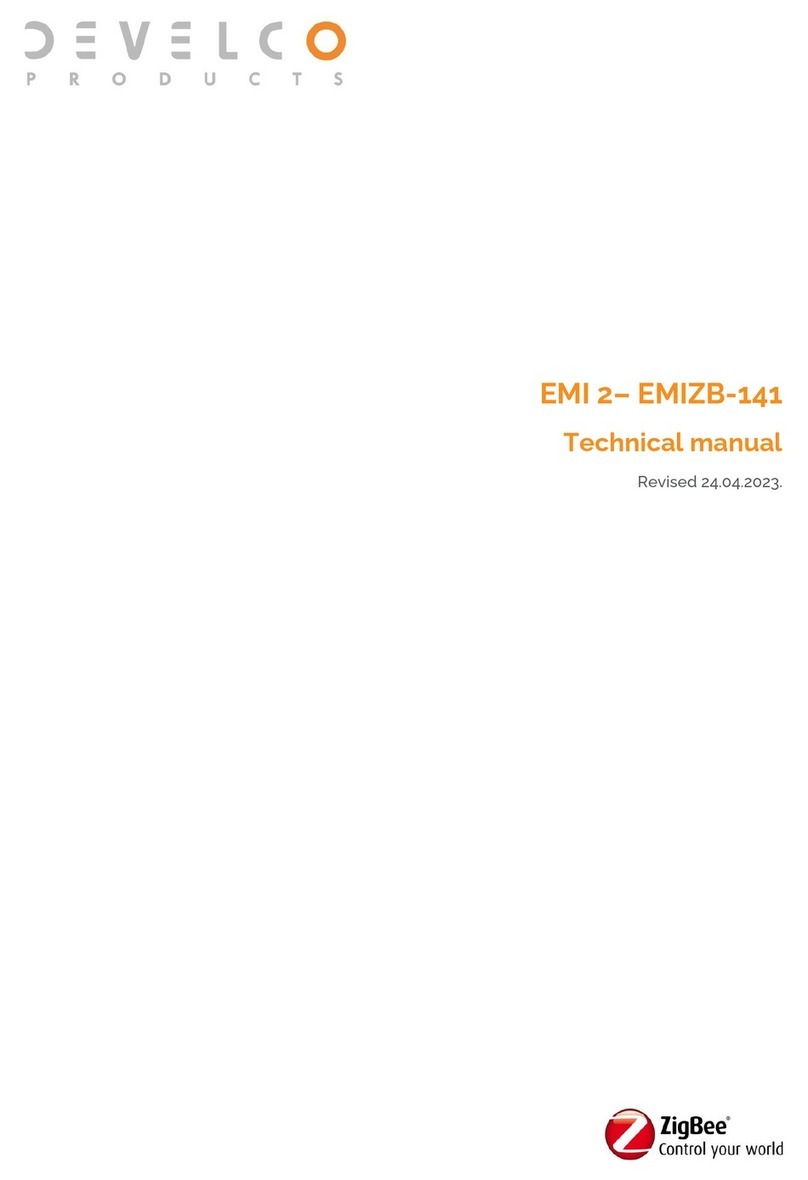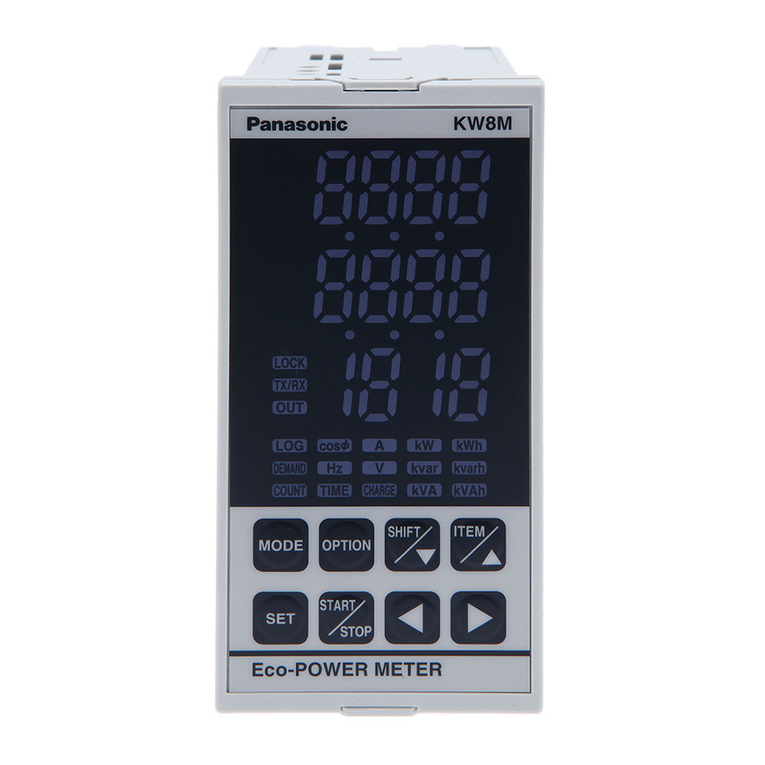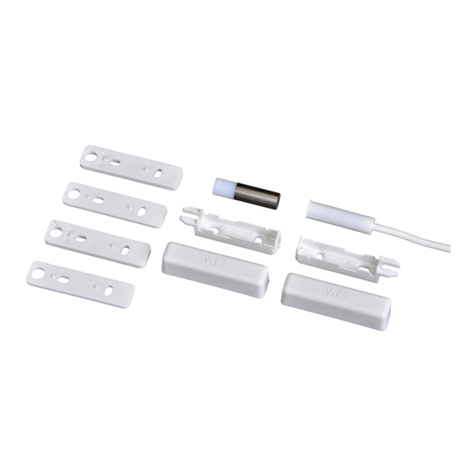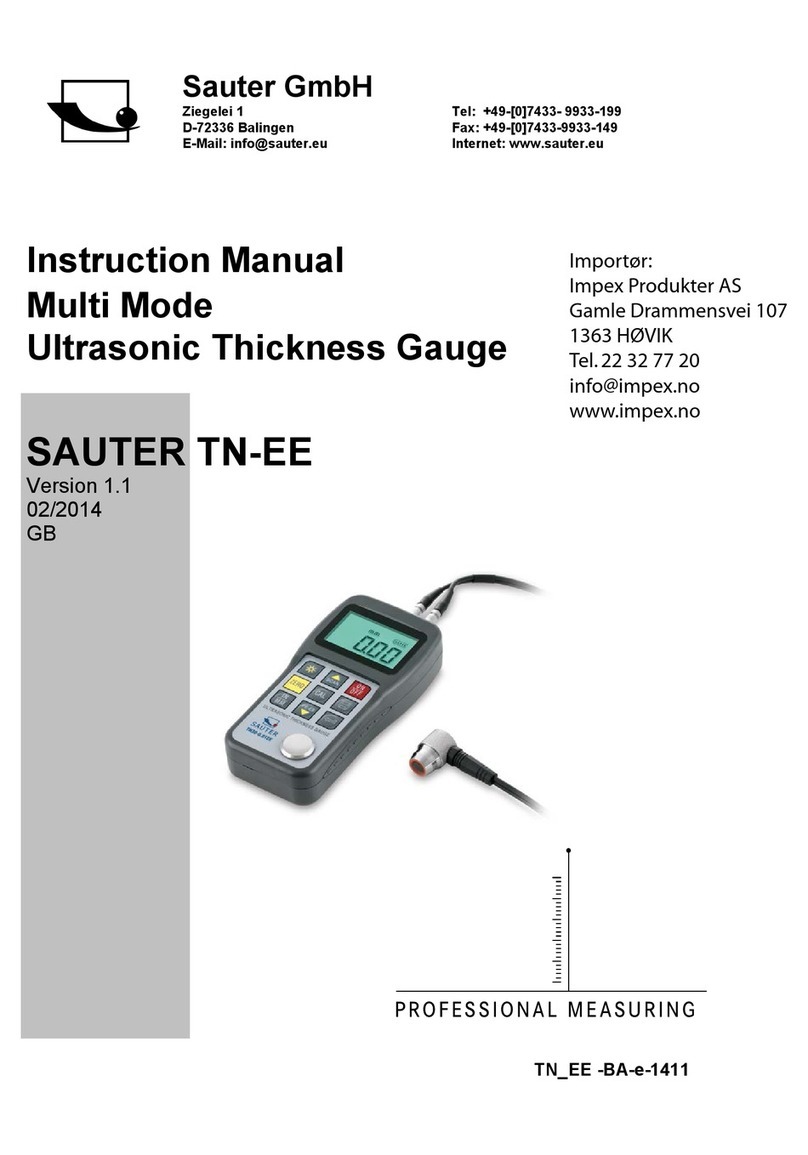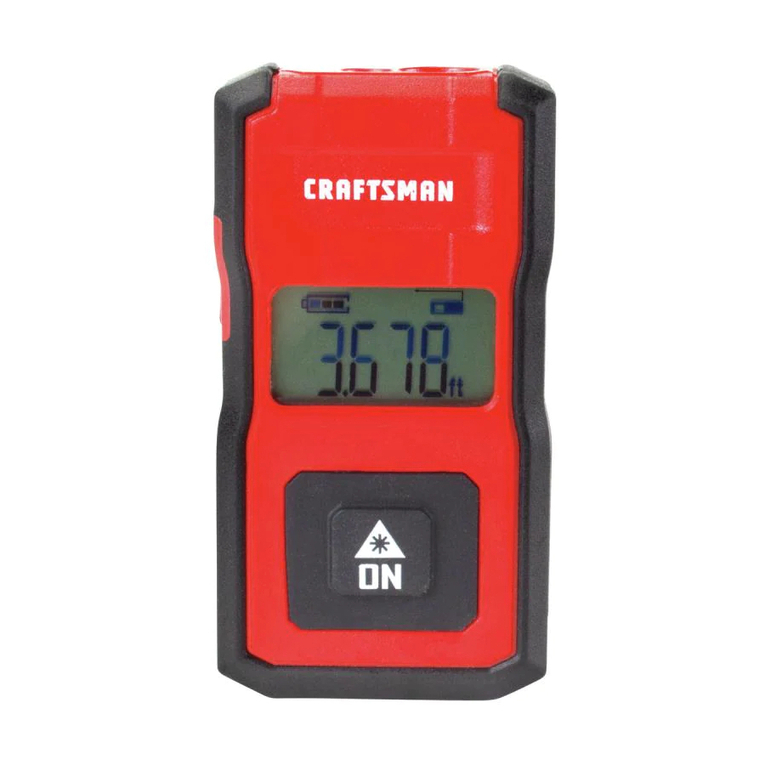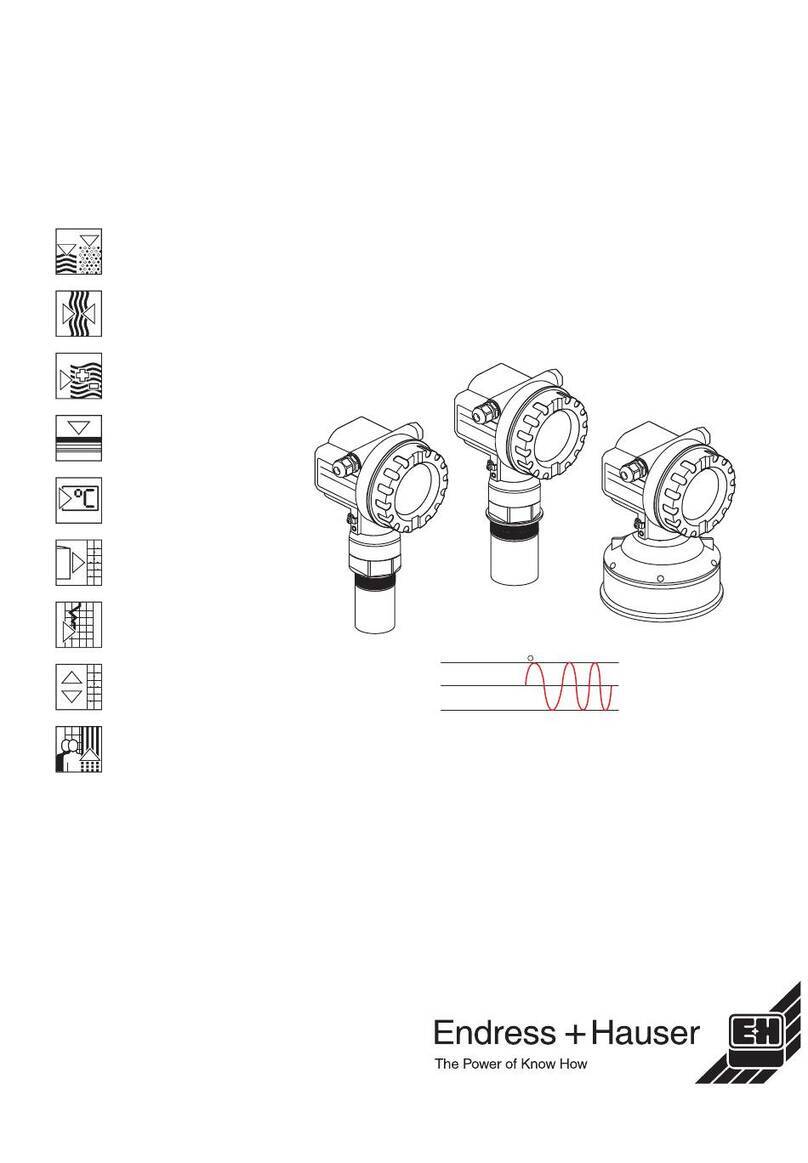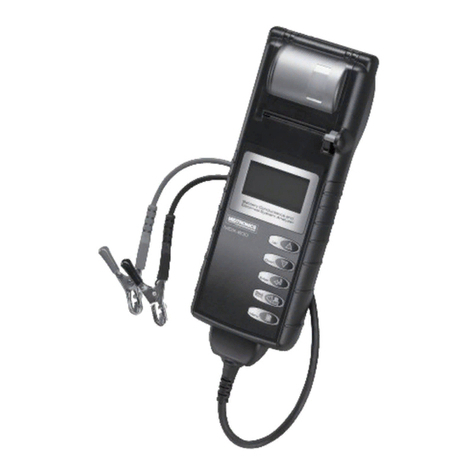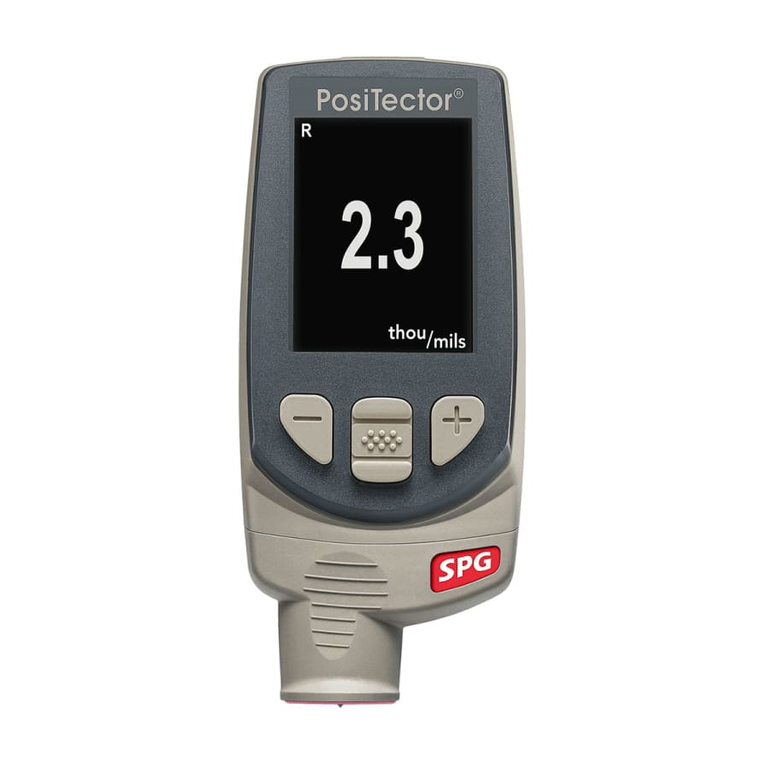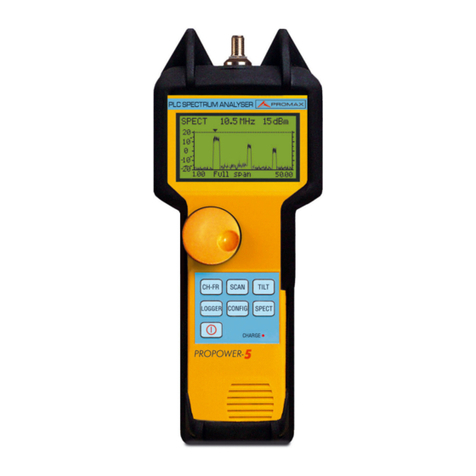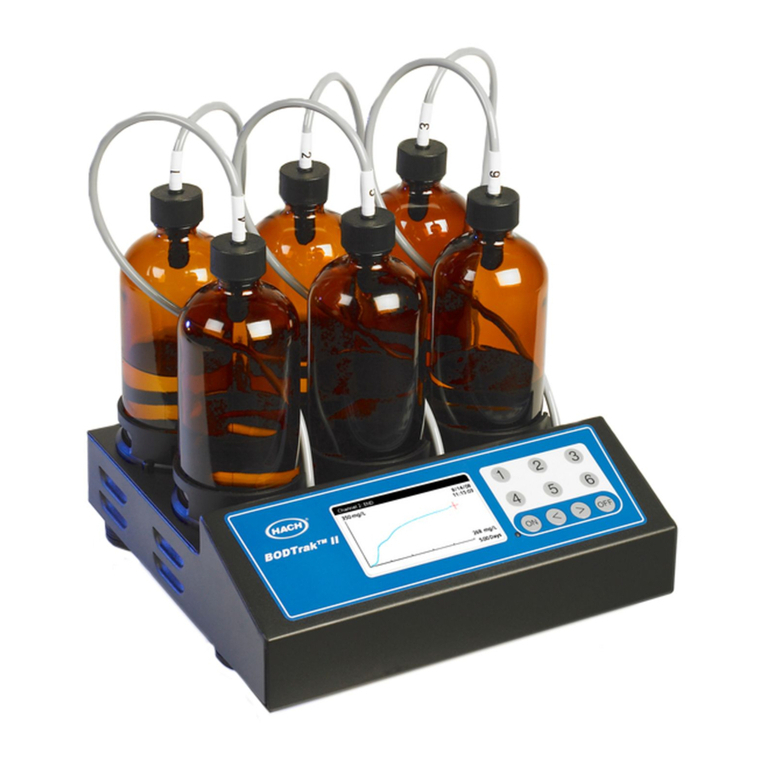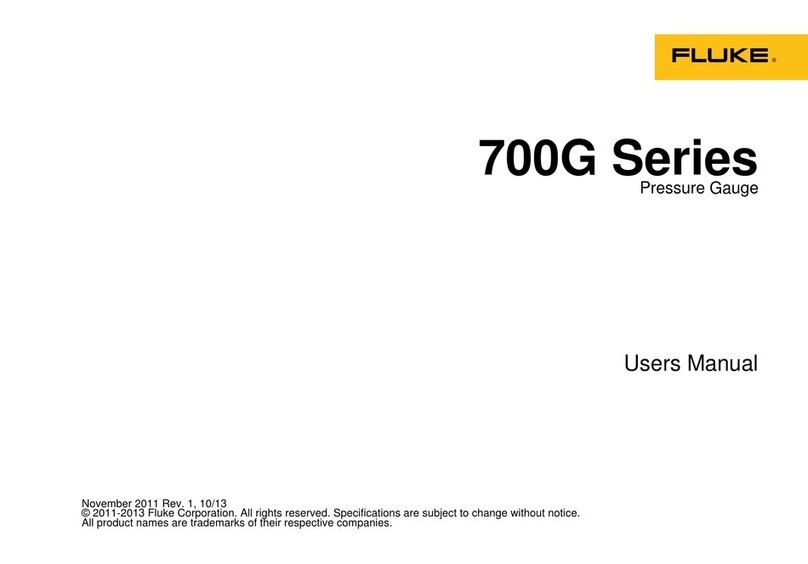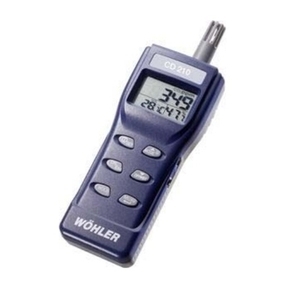Troxler Enhanced RoadReader Plus 3451 User manual

NOTE
The Model 3451 Enhanced RoadReader Plus is equipped with a
global positioning system (GPS) receiver. If the gauge is moved
a long distance between uses, the GPS system must be allowed
to initialize. In some instances, initialization may take as long as
30 to 45 minutes from the time the gauge is powered on withthe
GPS enabled. Note also that the gauge must be positioned such
that the GPS receiver can receive signals from the GPS
satellites (see page 1–5 for more information). If the GPS does
not initialize within 45 minutes, contact your Troxler
representative.
Manual of Operation and Instruction
Model 3451
Enhanced
RoadReader™ Plus
Surface Moisture-Density Gauge
Troxler Electronic Laboratories, Inc.
3008 Cornwallis Rd. •P.O. Box 12057
Research Triangle Park, NC 27709 U.S.A.
Phone: 1.877.TROXLER
Outside the USA: +1.919.549.8661
Fax: +1.919.549.0761
www.troxlerlabs.com

ii
Troxler gauges are protected by U.S. and foreign patents
Copyright 2004 – 2009
Troxler Electronic Laboratories, Inc.
All Rights Reserved
No part of this manual may be reproduced or transmitted in any
form or by any means, electronic or mechanical, including
photocopying, recording, or information storage and retrieval
systems, for any purpose without the express written permission of
Troxler Electronic Laboratories, Inc.
Bluetooth is a registered trademark of the Bluetooth Special Interest
Group (SIG).
Federal Express is a registered trademark of the Federal Express
Corporation.
Intermec is a registered trademark of Intermec Technologies Corp.
Magnalube-G is a registered trademark of Carleton-Stuart
Corporation.
Microsoft, Windows, Windows XP, Excel, and ActiveSync are
registered trademarks of Microsoft Corporation.
Pentium is a registered trademark of Intel Corporation.
RoadReader is a trademark of Troxler Electronic Laboratories, Inc.
WD-40 is a registered trademark of the WD-40 Company.
PN 110399
July 2009
Edition 3.1

Model 3451
iii
SAFETY ALERT SYMBOL
The Safety Alert Symbol shall appear within this manual. Wherever
it appears in this manual or on safety signs affixed to the machine,
this is to make all aware of the potential for personal injury and to
be cautious when these images are present.
Always observe all WARNING, CAUTION, and NOTE
recommendations listed within this manual before operating the
machine.

iv
TROXLER SERVICE CENTERS
Troxler Corporate Headquarters
3008 Cornwallis Road
P.O. Box 12057
Research Triangle Park, NC 27709
Phone: 1.877.TROXLER (1.877.876.9537)
Outside the U.S.A.: +1.919.549.8661
Fax: +1.919.549.0761
Web: www.troxlerlabs.com
Technical Support
Phone: 1.877.TROXLER (1.877.876.9537)
E-mail: TroxTechSupport@troxlerlabs.com
Florida Service Center
2376 Forsyth Road
Orlando, FL 32807
Fax: 407.681.3188
Texas Service Center
2016 East Randol Mill Road
Suite 406
Arlington, TX 76011
Fax: 817.275.8562
Illinois Service Center
1430 Brook Drive
Downers Grove, IL 60515
Fax: 630.261.9341
Northern California Service Center
11300 Sanders Drive, Suite 7
Rancho Cordova, CA 95742
Fax: 916.631.0541
Troxler European Subsidiary
Troxler Electronics GmbH
Gilchinger Strasse 33
D.82239 Alling nr. Munich, Germany
Phone: ++49.8141.71063
Fax: ++49.8141.80731
E-mail: troxler@t-online.de
NOTE
To locate an independent, Troxler-authorized service
partner near you, call 1.877.TROXLER
(1.877.876.9537).

Model 3451
v
HOW TO USE THIS MANUAL
Congratulations on the purchase of the Troxler Model 3451
Enhanced RoadReaderPlus. Troxler continues the proven
technology of its 3400 Series surface moisture-density gauges with
the Troxler Model 3451 Enhanced RoadReader Plus.
The Model 3451 Manual of Operation and Instruction contains
information on safely using this gauge. Also included in this manual
are safety warnings, gauge setup, troubleshooting, and general
maintenance.

vi
WARNING
Indicates conditions or procedures that, if not followed
correctly, may cause personal injury.
CAUTION
Indicates conditions or procedures that, if not followed
correctly, may cause equipment damage.
CONVENTIONS USED IN THIS MANUAL
Throughout this manual, symbols and special formatting are used to
reveal the purpose of the text as follows:
NOTE
Indicates important information that must be read to
ensure proper operation.
〈Button〉Angle brackets and a different typestyle indicate a
button or character (number or letter) to press on
the handheld personal digital assistant (PDA) or on
the keyboard of a personal computer (PC) when
using the Data Manager software provided with the
gauge. For example, “Press 〈Start〉” means to press
the button labeled Start.
Display A different typestyle is used in text to indicate
information or messages displayed on the PDA or
computer.
♦
Diamonds indicate a list of things needed (such as
equipment) or things to know.
✓
Check marks indicate the performance of an action.
With lists of check marks, follow the instructions in
the order of the check marks.
Triangles indicate that more than one option is
available. Carefully select the option that applies.

Model 3451
vii
NOTES

vii
TABLE OF CONTENTS
CHAPTER 1. INTRODUCTION TO THE MODEL 3451
Introduction................................................................................... 1–2
Global Positioning System Accuracy........................................... 1–5
Gauge Parts and Accessories........................................................ 1–8
Unpacking and Inspection .......................................................... 1–11
CHAPTER 2. THEORY OF OPERATION
Density.......................................................................................... 2–2
Moisture........................................................................................ 2–3
Thin Layer .................................................................................... 2–5
Calibration .................................................................................... 2–6
CHAPTER 3. GETTING STARTED
Model 3451 Illustration ................................................................ 3–3
Source Rod Positions.................................................................... 3–5
Before Using the Gauge and PDA................................................ 3–6
Turning the Gauge and PDA On................................................... 3–8
Troxler Menu.............................................................................. 3–10
RoadReader Plus Main Menu..................................................... 3–16
Project Files ................................................................................ 3–19
Status........................................................................................... 3–24
CHAPTER 4. USING THE GAUGE
Taking a Standard Count.............................................................. 4–2
Preparing a Test Site..................................................................... 4–7
Taking Measurements................................................................. 4–10
CHAPTER 5. SETUP AND TARGET MENUS
Gauge Setup Menu........................................................................ 5–2
Target.......................................................................................... 5–14
TABLE OF CONTENTS (Continued)
CHAPTER 6. ADJUSTING MEASUREMENTS
Calibration Offset..........................................................................6–2
Special Calibration......................................................................6–14

Model 3451
ix
CHAPTER 7. USING DATA MANAGER
Introduction...................................................................................7–3
System Requirements....................................................................7–4
Starting the Data Manager Program..............................................7–5
Manage Project Data .....................................................................7–6
View Project Configuration.........................................................7–11
Recover Projects..........................................................................7–19
APPENDIX A. RADIATION THEORY AND SAFETY
Radiation Theory..........................................................................A–2
Radiation Safety ...........................................................................A–5
Regulatory Requirements...........................................................A–14
Gauge Use Precautions...............................................................A–17
3451 Radiation Profile................................................................A–18
APPENDIX B. 3451 SPECIFICATIONS
Measurement Specifications.........................................................B–2
Radiological Specifications..........................................................B–5
Electrical Specifications...............................................................B–6
Mechanical Specifications............................................................B–7
APPENDIX C. TROUBLESHOOTING AND SERVICE
Diagnostics Menu.........................................................................C–2
Troubleshooting............................................................................C–9
Batteries......................................................................................C–24
Replacing Fuse ...........................................................................C–26
Mechanical Maintenance............................................................C–27
Replacement Parts......................................................................C–29
Returning the Gauge for Service................................................C–32

ix
TABLE OF CONTENTS (Continued)
APPENDIX D. TRANSPORTATION AND SHIPPING
U.S. Shipping Requirements........................................................ D–2
Canadian Shipping Requirements................................................ D–5
APPENDIX E. STANDARD COUNT LOG
APPENDIX F. UNIT CONVERSION
Measurement Units.......................................................................F–2
Radiological Units........................................................................F–2
APPENDIX G. SPECIAL EUROPEAN CONSIDERATIONS
Declaration of Conformity........................................................... G–2
Safety Warnings........................................................................... G–3
INDEX
WARRANTY

Model 3451
x
LIST OF FIGURES
Figure Title Page
1–1 Model 3451 Parts and Accessories............................1–9
2–1 Effect of Moisture on Depth of Measurement...........2–4
3–1 Model 3451 Illustration .............................................3–3
3–2 Back Panel Details.....................................................3–4
3–3 Source Rod Positions.................................................3–5
3–4 Troxler Menu...........................................................3–10
3–5 Notes Screen............................................................3–10
3–6 Calculator.................................................................3–11
3–7 Intermec Launcher Display......................................3–12
3–8 Windows Desktop....................................................3–12
3–9 Return to Troxler Menu...........................................3–13
3–10 Battery Status Display .............................................3–17
3–11 RoadReader Plus Software Main Menu...................3–18
3–12 Project Menu............................................................3–20
3–13 New Project Setup Wizard, Page 1..........................3–20
3–14 Project File Selector.................................................3–22
3–15 Project Data Display................................................3–22
3–16 Project Erase Prompt ...............................................3–23
3–17 Gauge Tools Menu...................................................3–24
3–18 Gauge Status Menu..................................................3–24
3–19 View Status Display.................................................3–25
3–20 View Constants Display...........................................3–25
3–21 Source Decay Menu.................................................3–27
3–22 GPS Location Display .............................................3–28
4–1 Standard Menu...........................................................4–2
4–2 Standard Count Position ............................................4–3
4–3 Standard Count Results..............................................4–5
4–4 View Standard Screen................................................4–6
4–5 Drill Rod Assembly...................................................4–8
4–6 Marking the Test Area...............................................4–8
4–7 Entering Project Notes.............................................4–12
4–8 Count Results, Soil Mode........................................4–13
4–9 Count Results, Asphalt Mode..................................4–16
4–10 Gauge Positioned Around a Core Site .....................4–18

xi
LIST OF FIGURES (Continued)
Figure Title Page
4–11 Gauge Positioned Over Designated Test Site..........4–19
4–12 Individual Count Results, Thin Layer Mode...........4–20
4–13 Averaged Count Results, Thin Layer Mode............4–20
5–1 Change Settings Menu ..............................................5–2
5–2 Gauge Setup Menu.................................................... 5–2
5–3 View Setup Display...................................................5–3
5–4 Set Units Menu..........................................................5–4
5–5 Mode Change Display...............................................5–6
5–6 Count Time Menu.....................................................5–7
5–7 Enter Code Menu ......................................................5–8
5–8 Enter Customer Name Menu.....................................5–8
5–9 Change User Code Menu ..........................................5–9
5–10 Depth Indicator Menu ............................................. 5–10
5–11 Leak Test Menu.......................................................5–11
5–12 Leak Test Interval Menu......................................... 5–12
5–13 Leak Test Date Menu..............................................5–13
5–14 Target Menus ..........................................................5–15
5–15 Proctor Value Menu................................................ 5–15
5–16 Input Proctor Value Display....................................5–16
5–17 Proctor File Selector................................................ 5–17
6–1 Offset Menu ..............................................................6–3
6–2 Wet Density Offset Select.........................................6–4
6–3 Input Wet Density Offset ..........................................6–4
6–4 Moisture Offset Select...............................................6–5
6–5 Input True Percent Moisture ..................................... 6–7
6–6 Enter Moisture Offset File Name..............................6–7
6–7 Input Moisture Value from Gauge ............................6–8
6–8 Input True Moisture ..................................................6–8
6–9 Offset File Selector....................................................6–9
6–10 Moisture Offset Erase Prompt................................. 6–11
6–11 Trench Offset Select................................................6–12
6–12 New Trench Offset Confirmation ...........................6–13
6–13 Soil Special Calibration Menu ................................6–15
6–14 Gauge Positioned Over Designated Test Site..........6–16
6–15 Input True Density ..................................................6–17

Model 3451
xii
LIST OF FIGURES (Continued)
Figure Title Page
6–16 Enter File Name.......................................................6–17
6–17 Special File Selector ................................................6–18
6–18 Special Calibration Erase Prompt............................6–18
6–19 Enter Rod Position...................................................6–19
6–20 Taking Measurements Around a Core Site..............6–20
6–21 Thin Lift Special Calibration Menu.........................6–21
6–22 Input Top Layer Thickness......................................6–22
6–23 Input True Density...................................................6–24
6–24 Thin Layer Special Calibration Results...................6–24
6–25 Enter File Name.......................................................6–24
6–26 Thin Lift File Selector..............................................6–25
6–27 Thin Lift Special Calibration Erase Prompt.............6–25
6–28 Input Number of Averages ......................................6–27
7–1 Data Manager Main Menu.........................................7–5
7–2 Manage a Project Menu.............................................7–6
7–3 Connect PDA to PC Prompt ......................................7–8
7–4 View a Project Display ..............................................7–8
7–5 Project Data Spreadsheet .........................................7–10
7–6 Print Active Project Menu .......................................7–11
7–7 Gauge Constants Display.........................................7–13
7–8 Project Setup Display...............................................7–14
7–9 Standard Counts Display .........................................7–14
7–10 Project Status Display..............................................7–16
7–11 Source Decay Display..............................................7–16
7–12 Stat Test Display......................................................7–18
7–13 Drift Test Display ....................................................7–18
7–14 Recover Project Menu .............................................7–19
7–15 Connect Gauge to PC Prompt..................................7–20
A–1 Diagram of an Atom.................................................A–2
A–2 Effect of Distance on Exposure................................A–7
A–3 Cleaning the Sliding and Fixed Blocks...................A–12
A–4 Model 3451 Gauge and Transport Case..................A–18

Model 3451
xiii
LIST OF FIGURES (Continued)
Figure Title Page
C–1 Diagnostics Menu......................................................C–3
C–2 Stat Test Menu ..........................................................C–3
C–3 View Stat Counts.......................................................C–4
C–4 Stat Test Results........................................................C–4
C–5 Review Stat Test .......................................................C–4
C–6 Drift Test Menu.........................................................C–6
C–7 View Drift Counts.....................................................C–7
C–8 Drift Test Results ......................................................C–7
C–9 Review Drift Test......................................................C–7
C–10 Replacing NiMH Battery Pack or Fuse...................C–25
D–1 Type A Package Testing Results.............................. D–4

Model 3451
xv
ATTENTION 3451 GAUGE OWNER
This unit contains functions that require an ACCESS CODE.
This code must be entered before these functions may be used.
The ACCESS CODE for this gauge is:
4012
This page should be removed if the access code is not to be
distributed to other parties or users of this gauge.

xvi
NOTES

Model 3451
1–11
CHAPTER 1
INTRODUCTION TO THE MODEL 3451
This chapter provides a brief overview of the Troxler Model 3451
Enhanced RoadReaderPlus, as well as an explanation of the
global positioning system (GPS). This chapter also includes a list of
the gauge parts and accessories, and instructions for unpacking and
inspecting the gauge.
CONTENTS
Introduction................................................................................... 1–2
Global Positioning System Accuracy........................................... 1–5
Gauge Parts and Accessories........................................................ 1–8
Unpacking and Inspection .......................................................... 1–11
1. INTRODUCTION

1–2
INTRODUCTION
Troxler’s Model 3451 Enhanced RoadReader Plus combines the
impressive features of the Model 3450 RoadReader Plus with
advanced global positioning system (GPS) and wireless
technologies to provide unparalleled performance, flexibility, ease
of use, and operator safety.
Like the 3450 gauge, the Model 3451 incorporates the proven
capabilities of Troxler’s 3400 (moisture/density) and 4640 (thin-
layer density) gauges in a single unit that can perform thin-layer,
backscatter, direct transmission, and moisture measurements. In
addition to the features found in the 3450 gauge:
♦The Model 3451 is controlled using a handheld personal digital
assistant (PDA), which allows the operator to stand away from
the gauge while operating it via Bluetoothwireless
communications.
♦An onboard GPS receiver enables the Model 3451 to store
precise GPS coordinates, along with the standard date andtime
stamp, for each measurement.
♦The Data Manager PDA to PC Model 3451 for Windows XP
software included with the gauge enables the operator to collect
project data from the PDA or gauge on a personal computer
(PC), print project configuration information, and recover data
from the gauge in case of an emergency (such as the loss of the
PDA).
With the Model 3451, the operator can quickly and precisely
measure the moisture content and density of construction materials.
The gauge’s features include:
♦Three measurement modes (soil, asphalt, and thin layer) for
precise compaction control readings in most construction
materials:
Soil Mode: For moisture/density determinations in soil, soil-
stone materials in layers of 4 inches or greater.
Asphalt Mode: For density determinations in asphalt or
hardened concrete layers of 4 inches or greater.
Thin Layer Mode: For density determinations in asphalt layers
of less than 4 inches.

Model 3451
1–3
♦
Calibration offsets (wet density, moisture, and trench) and
special calibrations (soil and thin layer) to expand measurement
possibilities, and to enhance gauge readings on materials that
may fall outside the range of factory calibration.
♦
Over 30 functions to facilitate all phases of testing compaction
on construction materials.
♦
To preserve battery life, the gauge shuts down automatically
after five hours of inactivity.
The Model 3451 meets or exceeds all applicable American Society
of Testing and Materials (ASTM) standards (or corresponding
equivalent), including:
♦
ASTM D-2950: Standard Test Method for Density of
Bituminous Concrete in Place by Nuclear Method.
♦
ASTM D-6938: Standard Test Methods for In-Place Density
and Water Content of Soil and Soil-Aggregate by Nuclear
Methods (Shallow Depth)
NOTE
As of November 2006, ASTM D-6938 replaced ASTM
D-2922: Standard Test Methods for Density of Soil and
Soil-Aggregate in Place by Nuclear Methods (Shallow
Depth) and ASTM D-3017: Standard Test Method for
Water Content of Soil and Rock in Place by Nuclear
Methods (Shallow Depth).
Any licensing issues discussed in this manual are for the United
States. To purchase a Model 3451 in Canada, owners must obtain a
radioisotope license from the Canadian Nuclear Safety Commission
(CNSC). The owner should obtain copies of the AECB Regulations
and the Transportation of Dangerous Goods Act and Regulations
(TDG). For other countries, please consult your local regulatory
agency.
1. INTRODUCTION
Table of contents
Other Troxler Measuring Instrument manuals
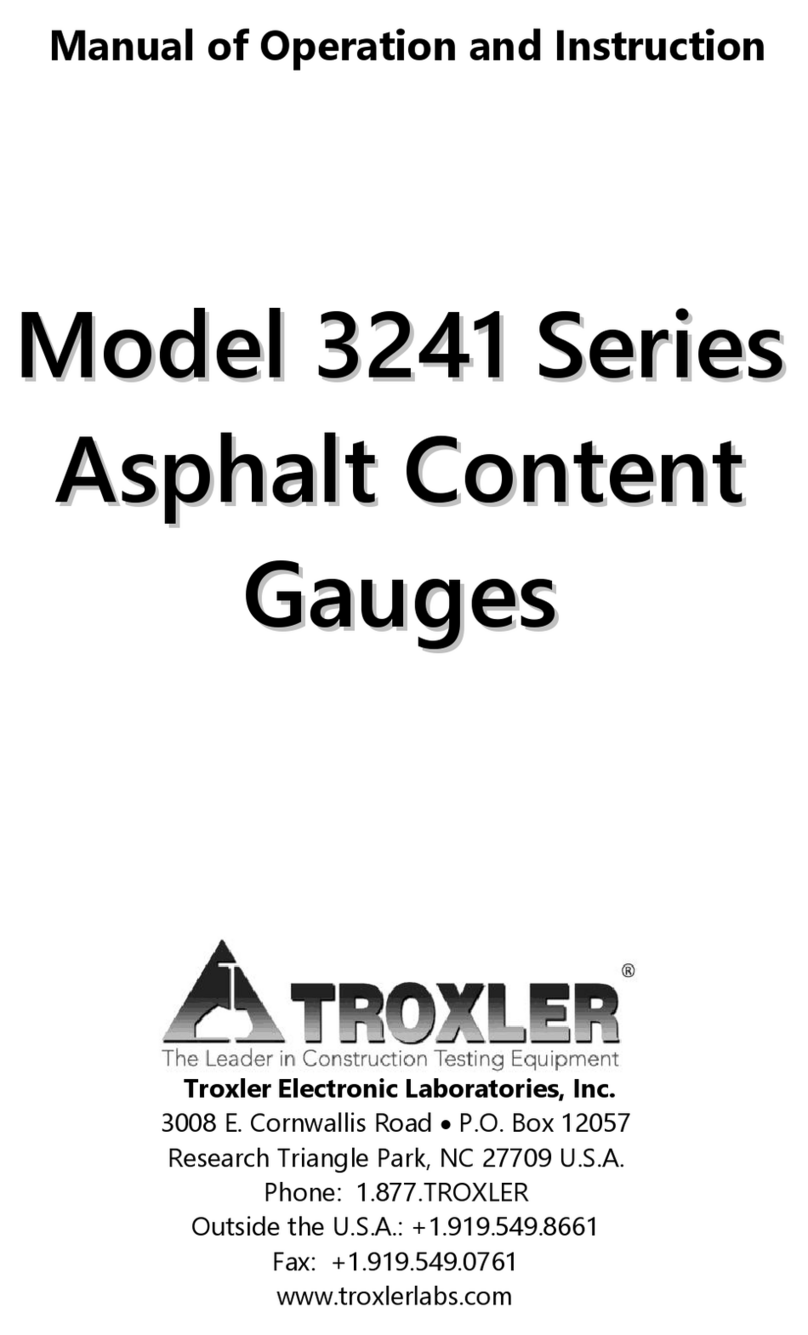
Troxler
Troxler 3241 Series User manual

Troxler
Troxler 3430 Plus User manual
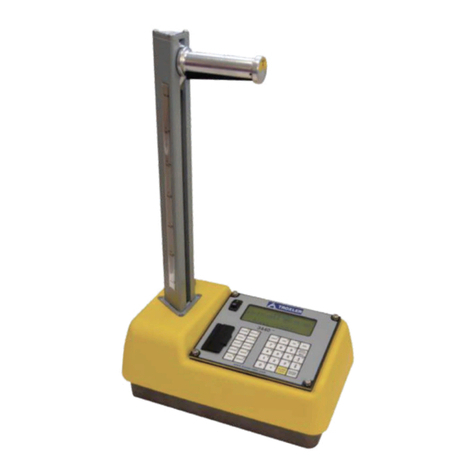
Troxler
Troxler 3440-L User manual
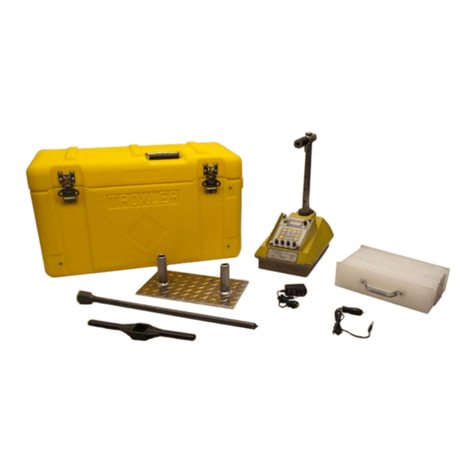
Troxler
Troxler 3400-B Series User manual
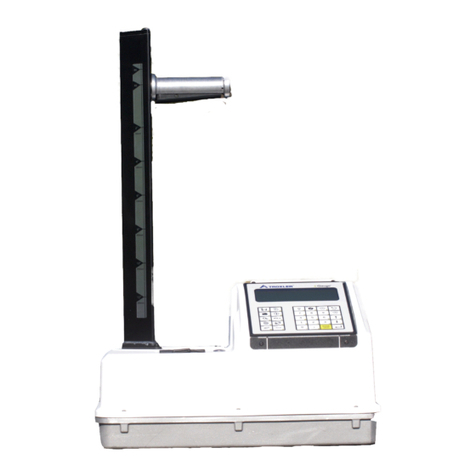
Troxler
Troxler EGauge Combo 4540 User manual

Troxler
Troxler EGauge 4590 User manual
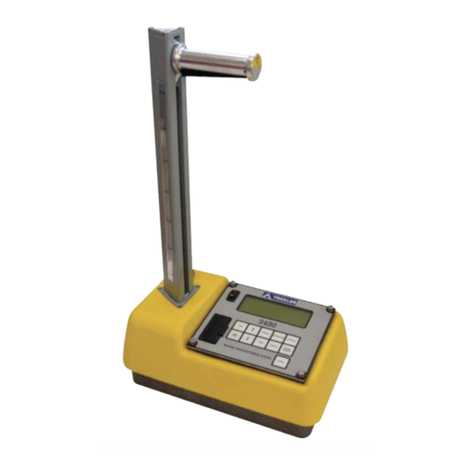
Troxler
Troxler RoadReader 3430 User manual
Troxler
Troxler PaveTracker Plus User manual
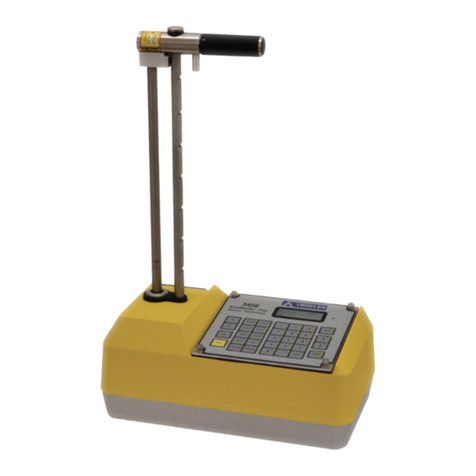
Troxler
Troxler RoadReader Plus 3450 User manual

Troxler
Troxler TroxAlert User manual



